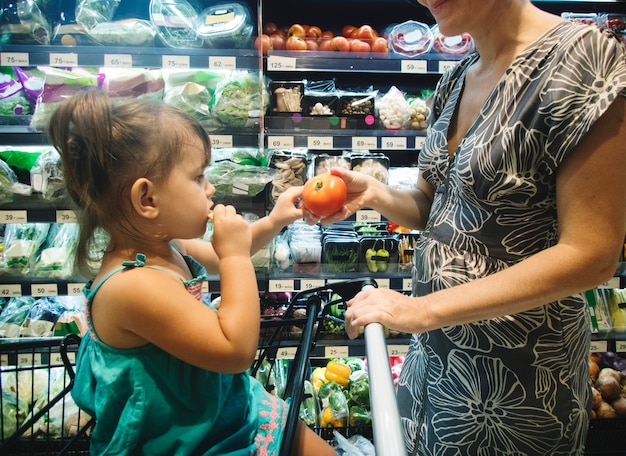WIC Program Updates 2025: New Guidelines & Food Items

WIC Program Updates for 2025 introduce revised Nutritional Guidelines and Eligible Food Items, aiming to enhance the nutritional well-being of pregnant women, new mothers, infants, and children under five in the United States.
The **WIC Program Updates: New Nutritional Guidelines and Eligible Food Items for 2025** are set to roll out, bringing significant changes to the support provided to millions of families across the United States. Understanding these updates is crucial for both participants and those considering applying for the program. These changes aim to promote healthier eating habits and improve access to nutritious foods for pregnant women, new mothers, infants, and young children.
Understanding the WIC Program
The Special Supplemental Nutrition Program for Women, Infants, and Children (WIC) is a federal assistance program dedicated to safeguarding the health of low-income pregnant, postpartum, and breastfeeding women, infants, and children up to age five who are at nutritional risk. It provides nutritious foods to supplement diets, information on healthy eating, and referrals to health care.
WIC’s Core Objectives
At its heart, WIC strives to achieve several key nutritional and health-related objectives. These include:
- Providing supplemental foods high in nutrients often lacking in the diets of WIC’s target population.
- Educating participants about nutrition and health, encouraging healthy eating habits.
- Connecting families with healthcare and other social services.
- Promoting and supporting breastfeeding as the optimal feeding method for infants.
WIC is more than just a food assistance program; it is a comprehensive support system aimed at fostering healthier families and communities. The program operates through state health departments and other local agencies, allowing for customization to address specific community needs.

In conclusion, the WIC program is a vital resource that plays a critical role in improving the health and well-being of vulnerable populations. Its impact extends beyond providing food, offering education and support that empowers families to make informed choices and build healthier futures.
Key Changes in Nutritional Guidelines for 2025
The WIC program is continuously evolving to reflect the latest scientific understanding of nutrition and health. For 2025, expect to see some significant updates to the nutritional guidelines that determine which foods are eligible under the program.
Focus on Dietary Guidelines for Americans
The updated guidelines will more closely align with the Dietary Guidelines for Americans, emphasizing the importance of:
- A diet rich in fruits, vegetables, and whole grains.
- Lean protein sources and low-fat dairy.
- Limiting added sugars, saturated fats, and sodium.
These changes aim to promote more balanced eating habits and reduce the risk of chronic diseases later in life.
Specific Nutrient Recommendations
Expect to see updated recommendations for specific nutrients, such as:
- Increased emphasis on Vitamin D and iron, particularly for infants and young children.
- Adjustments to the recommended intake of folic acid for pregnant women.
- Guidelines for appropriate portion sizes to address childhood obesity.
These nutrient-specific updates are designed to address common deficiencies and support optimal growth and development.
In conclusion, the nutritional guideline changes in 2025 mark a significant step forward in ensuring that the WIC program provides the most up-to-date and effective support for the health and well-being of its participants.
New Eligible Food Items in 2025
With the updated nutritional guidelines, the list of eligible food items under the WIC program will also see some changes. These revisions aim to provide participants with a wider variety of healthy options and better support their dietary needs.

Expansion of Fruit and Vegetable Options
Participants may see an expanded list of eligible fruits and vegetables, including:
- A greater variety of fresh produce, with allowances for seasonal options.
- Increased access to frozen and canned fruits and vegetables, with an emphasis on low-sodium and no-sugar-added varieties.
- Support for local farmers’ markets and community-supported agriculture (CSA) programs in some areas.
Whole Grain and Dairy Enhancements
The updates also include provisions for:
- A broader range of whole grain options, such as brown rice, whole wheat pasta, and certain types of cereals.
- Flexibility in dairy choices, with options for low-fat and non-dairy alternatives like soy milk and yogurt (with appropriate nutrient fortification).
- Increased availability of eggs and other lean protein sources.
These enhancements aim to make it easier for participants to meet the recommended dietary guidelines and enjoy a wider range of nutritious foods.
In conclusion, the changes to eligible food items in 2025 reflect a commitment to providing WIC participants with a comprehensive and up-to-date selection of healthy, nutritious foods that support their overall well-being.
Impact on WIC Participants
The WIC program updates, with their new nutritional guidelines and eligible food items, are expected to have a significant positive impact on program participants. These changes are designed to provide better support for their health and well-being.
Improved Nutritional Outcomes
The close alignment with the Dietary Guidelines for Americans will likely lead to improved nutritional outcomes among WIC participants. Specifically, the updates are expected to:
- Reduce the risk of nutrient deficiencies, such as iron deficiency anemia in infants and pregnant women.
- Promote healthier weight gain during pregnancy, leading to better birth outcomes.
- Encourage the development of healthy eating habits in young children, setting the stage for a lifetime of good health.
Greater Food Access
The expanded list of eligible food items will give WIC participants greater access to a wider variety of healthy foods. This increased food access will help to:
- Reduce food insecurity among low-income families.
- Improve the overall diet quality of WIC participants.
- Increase the likelihood that WIC participants will meet the recommended dietary guidelines.
These changes will make it easier for WIC participants to access healthy, nutritious foods and to make informed choices about their diets.
In conclusion, the WIC program updates for 2025 are designed to have a positive impact on participants’ health and well-being by improving nutritional outcomes, increasing food access, and empowering families to make healthier choices.
Eligibility Requirements for WIC in 2025
To benefit from the WIC program and its updated guidelines and food items, it’s important to understand the eligibility requirements. These requirements remain largely the same, focusing on income, category, and nutritional risk.
Income Guidelines
The WIC program has income guidelines that vary by state but generally require participants to have an income at or below 185% of the federal poverty level. To determine income eligiblity, consider the following:
- Gross income is considered, not net income.
- Income from all household members is added together.
- Some states have exceptions to the income guidelines for certain categories, such as pregnant women.
Categorical Requirements
To be eligible for WIC, individuals must also fall into one of the following categories:
- Pregnant women.
- Postpartum women (up to six months after delivery).
- Breastfeeding women (up to one year after delivery).
- Infants (up to one year of age).
- Children (up to age five).
Nutritional Risk Assessment
All WIC applicants must undergo a nutritional assessment to determine if they are at nutritional risk. This assessment may include:
- A review of medical history.
- A dietary assessment.
- A physical exam.
Risk factors vary per state, but examples may include anemia, underweight or overweight status, or a history of poor pregnancy outcomes.
In conclusion, ensuring the health and nutritional needs of eligible individuals is at the heart of WIC’s mission, and understanding these requirements ensures assistance reaches intended parties.
How to Apply for the WIC Program
Applying for the WIC program is a straightforward process, though it requires gathering some information and completing an application at a local WIC agency. Here’s a step-by-step guide to help potential applicants.
Find Your Local WIC Agency
The first step is to locate your local WIC agency. They are instrumental in this process as they:
- Provide location specific application information.
- Guide applicants through each step.
- Offer assistance answering questions.
Gather Required Documents
Before applying, it’s necessary to gather the required documents. These may include:
- Proof of income (e.g., pay stubs, tax returns, employment letter).
- Proof of residency (e.g., utility bill, lease agreement).
- Identification (e.g., driver’s license, passport, birth certificate).
- Medical records or information (if available) that document any nutritional risk factors.
Complete the Application and Attend the Appointment
After gathering the necessary documents, complete the WIC application and schedule an appointment with the local WIC agency. During the appointment, applicants will typically undergo a nutritional assessment, discuss their dietary habits, and learn about the benefits of the WIC program. This ensures:
- A greater understanding of benefits.
- That WIC’s resources are properly matched.
- The applicant better understands the program as whole.
In conclusion, the application is designed to ensure that those who are eligible for WIC receive the assistance they need to support their health and well-being, especially given the significant updates to the program in 2025.
Conclusion
The WIC Program Updates for 2025 represent an important step forward in ensuring that vulnerable populations have access to the nutritious foods and support they need to thrive. With updated nutritional guidelines, an expanded list of eligible food items, and a focus on improving nutritional outcomes, the WIC program is poised to make an even greater impact on the health and well-being of women, infants, and children across the United States.
| Key Point | Brief Description |
|---|---|
| 🌱 New Guidelines | Updated WIC nutritional standards align with Dietary Guidelines for Americans. |
| 🍎 Expanded Foods | More fruits, vegetables, grains, and protein options are now WIC eligible. |
| 👪 Impact | Aims to improve diet, reduce risk of chronic illness and empower informed dietary action. |
| 📝 Eligibility | Income, category (pregnant, infant, child etc) and a nutritional risk assessment determine WIC eligibility. |
Frequently Asked Questions
▼
WIC is the Special Supplemental Nutrition Program for Women, Infants, and Children. It provides food, nutrition education, and healthcare referrals to low-income pregnant, breastfeeding, and postpartum women, infants, and children up to age five.
▼
Eligibility includes pregnant women, postpartum women (up to six months after delivery), breastfeeding women (up to one year after delivery), infants (up to one year of age), and children (up to age five) who meet income guidelines and are at nutritional risk.
▼
New eligible food items in 2025 include a wider variety of fruits and vegetables, whole grain options, and low-fat dairy alternatives like soy milk and yogurt. These changes aim to support participants’ dietary needs.
▼
The WIC program helps families by providing nutritious foods to supplement their diets, offering nutrition education to promote healthy eating habits, and connecting them with healthcare and other social services for comprehensive support.
▼
To apply for WIC, find your local WIC agency, gather necessary documents (proof of income, residency, identification), complete the required application, and attend an appointment for a nutritional assessment and program orientation.
Conclusion
The WIC program remains an essential resource for women, infants, and children, and the 2025 updates demonstrate a continued commitment to improving the health and well-being of its participants through enhanced nutritional support and education.
